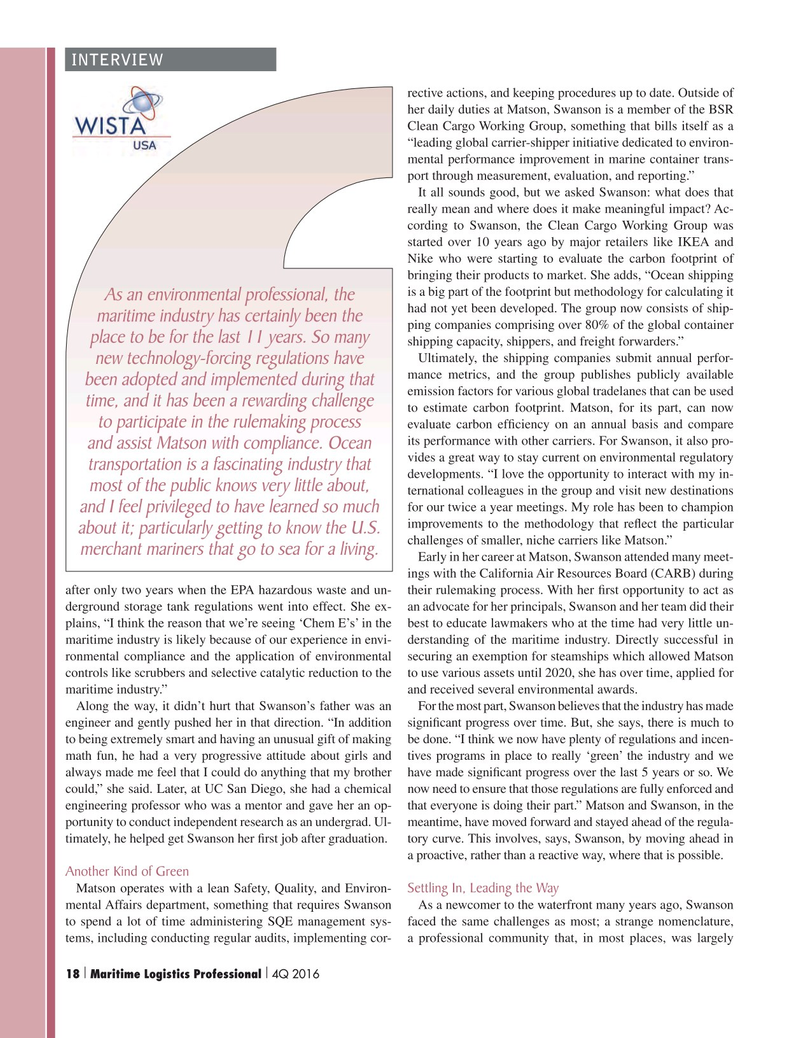
Page 18: of Maritime Logistics Professional Magazine (Q4 2016)
Workboats
Read this page in Pdf, Flash or Html5 edition of Q4 2016 Maritime Logistics Professional Magazine
INTERVIEW rective actions, and keeping procedures up to date. Outside of her daily duties at Matson, Swanson is a member of the BSR
Clean Cargo Working Group, something that bills itself as a “leading global carrier-shipper initiative dedicated to environ- mental performance improvement in marine container trans- port through measurement, evaluation, and reporting.”
It all sounds good, but we asked Swanson: what does that really mean and where does it make meaningful impact? Ac- cording to Swanson, the Clean Cargo Working Group was started over 10 years ago by major retailers like IKEA and
Nike who were starting to evaluate the carbon footprint of bringing their products to market. She adds, “Ocean shipping is a big part of the footprint but methodology for calculating it
As an environmental professional, the had not yet been developed. The group now consists of ship- maritime industry has certainly been the ping companies comprising over 80% of the global container place to be for the last 11 years. So many shipping capacity, shippers, and freight forwarders.”
Ultimately, the shipping companies submit annual perfor- new technology-forcing regulations have mance metrics, and the group publishes publicly available been adopted and implemented during that emission factors for various global tradelanes that can be used time, and it has been a rewarding challenge to estimate carbon footprint. Matson, for its part, can now to participate in the rulemaking process evaluate carbon ef? ciency on an annual basis and compare its performance with other carriers. For Swanson, it also pro- and assist Matson with compliance. Ocean vides a great way to stay current on environmental regulatory transportation is a fascinating industry that developments. “I love the opportunity to interact with my in- most of the public knows very little about, ternational colleagues in the group and visit new destinations for our twice a year meetings. My role has been to champion and I feel privileged to have learned so much improvements to the methodology that re? ect the particular about it; particularly getting to know the U.S. challenges of smaller, niche carriers like Matson.” merchant mariners that go to sea for a living.
Early in her career at Matson, Swanson attended many meet- ings with the California Air Resources Board (CARB) during after only two years when the EPA hazardous waste and un- their rulemaking process. With her ? rst opportunity to act as derground storage tank regulations went into effect. She ex- an advocate for her principals, Swanson and her team did their plains, “I think the reason that we’re seeing ‘Chem E’s’ in the best to educate lawmakers who at the time had very little un- maritime industry is likely because of our experience in envi- derstanding of the maritime industry. Directly successful in ronmental compliance and the application of environmental securing an exemption for steamships which allowed Matson controls like scrubbers and selective catalytic reduction to the to use various assets until 2020, she has over time, applied for maritime industry.” and received several environmental awards.
Along the way, it didn’t hurt that Swanson’s father was an For the most part, Swanson believes that the industry has made engineer and gently pushed her in that direction. “In addition signi? cant progress over time. But, she says, there is much to to being extremely smart and having an unusual gift of making be done. “I think we now have plenty of regulations and incen- math fun, he had a very progressive attitude about girls and tives programs in place to really ‘green’ the industry and we always made me feel that I could do anything that my brother have made signi? cant progress over the last 5 years or so. We could,” she said. Later, at UC San Diego, she had a chemical now need to ensure that those regulations are fully enforced and engineering professor who was a mentor and gave her an op- that everyone is doing their part.” Matson and Swanson, in the portunity to conduct independent research as an undergrad. Ul- meantime, have moved forward and stayed ahead of the regula- timately, he helped get Swanson her ? rst job after graduation. tory curve. This involves, says, Swanson, by moving ahead in a proactive, rather than a reactive way, where that is possible.
Another Kind of Green
Matson operates with a lean Safety, Quality, and Environ- Settling In, Leading the Way mental Affairs department, something that requires Swanson As a newcomer to the waterfront many years ago, Swanson to spend a lot of time administering SQE management sys- faced the same challenges as most; a strange nomenclature, tems, including conducting regular audits, implementing cor- a professional community that, in most places, was largely 18 Maritime Logistics Professional 4Q 2016| | 18-33 Q4 MP2016.indd 18 11/10/2016 10:27:27 AM

 17
17

 19
19
